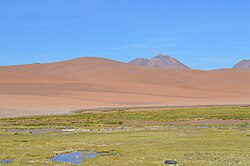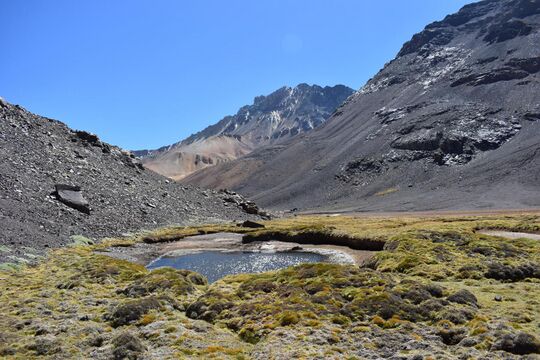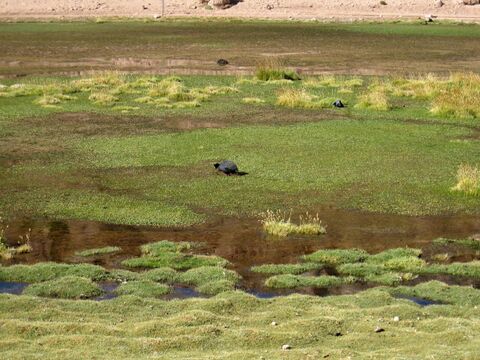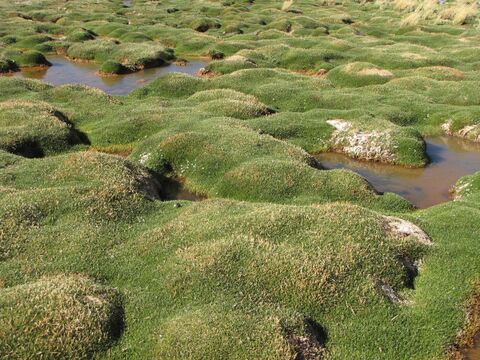Earth:Bofedales

Bofedales (singular bofedal), known in some parts of Peru as oconales, are a type of wetland found in the Andes. They are a feature in the land use and ecology of high Andean ecosystems. They form in flat areas around ponds or streams and may be permanent or seasonal, and they can be man made or natural. Bofedales are associated with organic material in the soil and their green colour often contrasts with that of the drier surrounding landscape.
They are found at elevations exceeding 3,800 metres (12,500 ft) above sea level. Bofedales absorb the limited amount of water derived from snow, glacier meltwater and rain showers, storing it in ground and slowly releasing it. Their vegetation is dominated by cushion plants. Numerous animals including birds, mammals and invertebrates occur in bofedales. They are used by humans, who have created new such wetlands through irrigation, but human activities can also be a threat to these ecosystems.
Name and classification
Bofedal is the singular term; the plural is Bofedales.[1] The Quechua languages have terms like oqho, hoq’o, waylla and qochawiña, while the Aymara language terms are juqhu and jukhu; there are also spelling variants.[2] Vega refers to wetlands, which frequently but not always are bofedales.[3] The term "bofedal"/"bofedales" is frequently used for other types of wetlands or Andean ecosystems that do not need the definition.[2]
Characteristics
Bofedales are wetlands featuring cushion plants[3] in the Andes between Colombia and Venezuela in the north to Patagonia in the south.[4] The surrounding drier, yellow landscape contrasts notably with the green bofedales,[1][5] creating landscapes of great aesthetic value.[6] The tropical Andes feature numerous vegetation zones, with the páramo in the north having the highest humidity. To the south moisture decreases and the distinction between the wet season and dry season increases, yielding the transition from the páramo to the jalca vegetation and finally to the puna grassland. The Puna contains both xerophytic and wet sections.[1] Analogous ecosystems exist in the mountains of East Africa, Hawaii and New Guinea.[7]
The landscape of a bofedal features ponds, lawns and hummocks.[8] Plants growing in bofedales form cushions,[9] meadows, shrubs or flat-growing forms.[10] The bofedales can reach sizes of more than 1 square kilometre (0.39 sq mi) or less than 1 hectare (2.5 acres).[8] In Chile, long and narrow bofedales form at the bottom of valleys.[5] They usually form on flat terrain, next to ponds, springs and streams,[1] but most of the water is underground.[11] The water originates as groundwater or from rivers, lakes and glaciers and is only slowly released by the bofedales, which thus constitute important water stores[12] for the dry season,[13] allowing streams to continue flowing.[7] Almost all river systems in southern Peru have bofedales in their headwaters.[14]
The climate conditions are often extreme, featuring high insolation and strong winds, lack of precipitation and oxygen due to the thin atmosphere at these elevations, low temperatures with daily frosts and a short growing season.[15] Bofedales sometimes exist only seasonally, others are present year-round.[16] They feature peat or organic soils[1] that can store significant quantities of carbon,[17] equivalent to ten times that of normal Sphagnum peat.[13] They retain and filtrate nutrients.[7] Sometimes the ground is so soft that animals can sink into it.[10] Where bofedales have been dated, such as in Chile, they began development during the Holocene and often only during the last few millennia, when conditions became wetter.[18]
Occurrence
(As of 2012), almost 549.36 square kilometres (212.11 sq mi) of Peru were covered by bofedales; this is about 0.4% of the country.[1] Remote sensing found that in 1992–1993 about 1.4% of the Altiplano, about 2,064 square kilometres (797 sq mi), were bofedales.[19] In Chile large swathes of the Altiplano in the regions of Arica y Parinacota and Tarapacá are covered by bofedales. Relative to this region bofedales in the more arid Antofagasta Region are smaller and more isolated.[20] The southernmost bofedales of the Central Andes are found at the latitude of the Nevado Tres Cruces National Park in Chile.[18]
Flora and fauna
The most important plant species in bofedales are cushion plants, including the Juncaceae Distichia muscoides and Oxychloe andina.[4] About 61 to 62 different plant species have been recorded in Central Andean bofedales.[11] They do not occur in every bofedal; species composition varies between regions and different parts of the same bofedal. The species composition may vary due to grazing pressure and seed dispersal by animals, water availability and temperature, the presence of nutrients and toxic elements, and different stages of the ecological succession.[6][21][22] Many of these plant species are endemic.[7] Bofedales have a high biological productivity,[6] the highest of all ecosystems in the Puna.[4]
The water of bofedales provides habitats to amphibians like frogs (Acancocha water frog, common marsupial frogs and Pleurodema marmoratum) and toads (Rhinella spinulosa).[12] Numerous invertebrates like annelids, crustaceans, insects, planarians and snails live in bofedales.[23] Birds living in bofedales include Andean geese, Andean lapwings, Andean negritos, buff-winged cinclodes, crested ducks, Darwin's rheas, golden-spotted ground doves, grey-breasted seedsnipes and yellow-billed teals. The food resources of bofedales also draw mammals like Andean deer, Andean foxes, guanacos, various species of mice,[lower-alpha 1] pampas cats, pumas, white-tailed deer, vicuñas and vizcachas.[12]
Human use
Bofedales are an important economic resource.[24] At their elevations climatic conditions make agriculture unfeasible, while the high quality of the forage in bofedales invites animal husbandry.[25] On the Altiplano, in drier areas they are the most important pasture.[6] Alpacas, cattle, horses, llamas and sheep are fed there.[26] Plants used in medicine or in spiritual activities are taken from bofedales.[27]
Bofedales can be artificial,[1] and many may have formed through the irrigation of pastures. Some bofedales are artificially created and sustained through irrigation to this day.[25] Many more are at least partially modified by human activity. The Aymara and Quechua peoples have maintained traditional knowledge about the bofedales including irrigation techniques, animal rotation and the use of fire to remove dry plants.[27] The human engineering of bofedales is poorly studied.[28]
Threats and conservation
The use of bofedales for pasture frequently results in overgrazing,[29] although it may not always be detrimental to bofedal function.[30] More localized threats to bofedales are mining and the extraction of peat, which can result in severe damage.[29] Other infrastructure projects threatening bofedales are dams, road projects,[31] and the diversion of their water sources.[32] Global warming is a further threat to these ecosystems[33] as decreased precipitation[34] and glacier retreat reduces the flow of water into bofedales, which is necessary to sustain them.[32] Whether the activities of local communities are a threat or a benefit to bofedales is unclear.[35]
Bofedales are biodiversity hotspots,[24] and many of the animal species living in them are threatened.[8] Bofedales are important ecosystems in the mountains, with high levels of species diversity and endemism, and their ability to retain water reduces erosion and maintains water resources.[13] Within the Ramsar Convention, they are counted as unforested peatlands.[1] Some bofedales are included in protected areas but (As of 2014), none were the subject of a dedicated protected area. They are considered to be vulnerable ecosystems under Peruvian environmental law.[29] In Chile, some regions require special permissions to withdraw water from bofedales and their watersheds.[8]
Gallery
See also
- Dispute over the Status and Use of the Waters of the Silala, a case at the International Court of Justice about the Silala River
- Fell
- Mallín
Notes
- ↑ Including Akodon boliviensis, Auliscomys pictus, Calomys lepidus, Necromys amoenus, Phyllotis osilae and Phyllotis xanthopygus.[12]
References
- ↑ 1.0 1.1 1.2 1.3 1.4 1.5 1.6 1.7 Fonkén 2014, p. 1.
- ↑ 2.0 2.1 White-Nockleby et al. 2021, p. 5.
- ↑ 3.0 3.1 White-Nockleby et al. 2021, p. 3.
- ↑ 4.0 4.1 4.2 White-Nockleby et al. 2021, p. 1.
- ↑ 5.0 5.1 Squeo et al. 2006, p. 249.
- ↑ 6.0 6.1 6.2 6.3 Zorogastúa-Cruz 2012, p. 64.
- ↑ 7.0 7.1 7.2 7.3 Polk et al. 2019, p. 1.
- ↑ 8.0 8.1 8.2 8.3 Squeo et al. 2006, p. 246.
- ↑ Fonkén 2014, p. 4.
- ↑ 10.0 10.1 Fonkén 2014, p. 5.
- ↑ 11.0 11.1 Carrasco et al. 2020, p. 117.
- ↑ 12.0 12.1 12.2 12.3 Fonkén 2014, p. 6.
- ↑ 13.0 13.1 13.2 Loza Herrera, Meneses & Anthelme 2015, p. 40.
- ↑ Cunya & Jiménez 2019, p. 2.
- ↑ Squeo et al. 2006, p. 245.
- ↑ White-Nockleby et al. 2021, p. 9.
- ↑ Fonkén 2014, p. 7.
- ↑ 18.0 18.1 Squeo et al. 2006, p. 252.
- ↑ Zorogastúa-Cruz 2012, p. 68.
- ↑ Villagrán & Castro 1997, p. 280.
- ↑ Fonkén 2014, pp. 4-6.
- ↑ Squeo et al. 2006, pp. 246,251.
- ↑ Carrasco et al. 2020, p. 121.
- ↑ 24.0 24.1 Fonkén 2014, p. 2.
- ↑ 25.0 25.1 Fonkén 2014, p. 8.
- ↑ Fonkén 2014, p. 3.
- ↑ 27.0 27.1 White-Nockleby et al. 2021, p. 2.
- ↑ White-Nockleby et al. 2021, p. 8.
- ↑ 29.0 29.1 29.2 Fonkén 2014, p. 9.
- ↑ White-Nockleby et al. 2021, p. 11.
- ↑ Fonkén 2014, p. 10.
- ↑ 32.0 32.1 Loza Herrera, Meneses & Anthelme 2015, p. 41.
- ↑ Loza Herrera, Meneses & Anthelme 2015, p. 39.
- ↑ Polk et al. 2019, p. 2.
- ↑ White-Nockleby et al. 2021, p. 10.
Sources
- Carrasco, Carlos; Rayme, Carolina; Alarcón, Rosa-del-Pilar; Ayala, Yuri; Arana, Jerry; Aponte, Héctor; Carrasco, Carlos; Rayme, Carolina et al. (September 2020). "Macroinvertebrados acuáticos en arroyos asociados con bofedales altoandinos, Ayacucho Perú" (in es). Revista de Biología Tropical 68: 116–131. doi:10.15517/rbt.v68is2.44344. ISSN 0034-7744. https://www.scielo.sa.cr/scielo.php?script=sci_arttext&pid=S0034-77442020000600116.
- Cunya, Marianella Crispin; Jiménez, Luis Alberto (2019). "Valoración económica ambiental de los bofedales del distrito de Pilpichaca, Huancavelica, Perú" (in es). Natura@ economía 4 (1): 1–13. doi:10.21704/ne.v4i1.1299. https://dialnet.unirioja.es/servlet/articulo?codigo=9095429.
- Fonkén, MS Maldonado (2014). "An introduction to the bofedales of the Peruvian High Andes". Mires and Peat 15 (5): 1–13. ISSN 1819-754X.
- Loza Herrera, Susi; Meneses, Rosa I.; Anthelme, Fabien (April 2015). "Comunidades vegetales de los bofedales de la Cordillera Real (Bolivia) bajo el calentamiento global". Ecología en Bolivia 50 (1): 39–56. ISSN 1605-2528. http://www.scielo.org.bo/scielo.php?pid=S1605-25282015000100004&script=sci_abstract&tlng=pt.
- Polk, M. H.; Young, K. R.; Cano, A.; León, B. (2019). "Vegetation of Andean wetlands (bofedales) in Huascarán National Park, Peru". Mires & Peat 24 (24). doi:10.19189/MaP.2018.SNPG.387. http://mires-and-peat.net/media/map24/map_24_01.pdf.
- Villagrán, Carolina M.; Castro, Victoria R. (1997). "Etnobotánica Y Manejo Ganadero De Las Vegas, Bofedales Y Quebradas En El Loa Superior, Andes De Antofagasta, Segunda Región, Chile" (in en). Chungara: Revista de Antropología Chilena 29 (2): 275–304. ISSN 0716-1182. https://www.jstor.org/stable/27802065.
- Squeo, Francisco; Warner, Barry; Aravena, Ramón; Espinoza, Diana (2006). "Bofedales: turberas de alta montaña de los Andes centrales" (PDF). Revista Chilena de Historia Natural 79 (2): 245–255. doi:10.4067/S0716-078X2006000200010. ISSN 0716-078X. http://biblioteca.cehum.org/handle/123456789/669.
- White-Nockleby, Caroline; Prieto, Manuel; Yager, Karina; Meneses, Rosa Isela (December 2021). "Understanding Bofedales as Cultural Landscapes in the Central Andes" (in en). Wetlands 41 (8): 102. doi:10.1007/s13157-021-01500-y. Bibcode: 2021Wetl...41..102W. https://link.springer.com/article/10.1007/s13157-021-01500-y.
- Zorogastúa-Cruz, P. (2012). "Dinamica de los bofedales en el altiplano peruano-boliviano". Revista Latinoamericana de Recursos Naturales 8 (2): 63–75. https://revista.itson.edu.mx/index.php/rlrn/article/view/202.
 |





